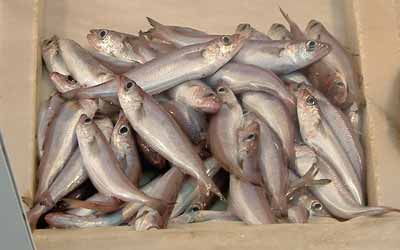
A name in Liguria for the big-scale atherine, a type of atherine similar to the sand smelt. A marine fish, usually deep-fried, it is a small, silvery fish similar to the argentine. When tiny it is treated in the same way as whitebait. This fish grows up to 12 cm.
"Gossip. Chatter." Deep fried biscuits (US: cookies) flavoured with lemon that are eaten as a ‘farewell to joy’ during the week leading up to Ash Wednesday. They are tortellini-like pasta knots stuffed with candied fruits, orange, cinnamon, ricotta, lemon and sugar or savoury versions with cream cheese stuffings. Sweet ones have sugar sprinkled on them.
"Gossip. Chatter." A Milanese name for chiacchiere della nonna, deep fried biscuits (US: cookies) flavoured with Marsala that are eaten as a ‘farewell to joy’ during the week leading up to Ash Wednesday. They are tortellini-like pasta knots stuffed with candied fruits, orange, cinnamon, ricotta, lemon and sugar or savoury versions with cream cheese stuffings. Sweet ones have sugar sprinkled on them.
"Wine call." A dish from Catania and Sicily of penne-like pasta or vermicelli sprinkled with anchovies, black pepper and breadcrumbs and then fried. The reason for the name is that it makes you so thirsty you call for wine.
A breed of cattle in Tuscany from which the best steaks were traditionally taken. Friends who own a house in the Chiana valley observed that they never saw cattle there at all and were told by a local farmer that they are no longer found in the valley.
Full, fruity red wines of varying quality from Tuscany, the largest DOC area in Italy. There are seven zones of Chianti: Chianti Classico, Chianti Colli Aretini, Chianti Colli Fiorentino, Chianti Colli Senesi, Chianti Colline Pisane, Chianti Montalbano and Chianti Rufina. Wines from Chianti Classico and Rufina are particularly distinguished. Chianti Classico describes wines made in the heart of Chianti, the original wines and of fine quality. The word "vecchio" indicates that a wine has been aged for two years, while "riserva" is aged for three. Chianti is sold in distinctive bottles in which the swollen base is encased in woven raffia known as a fiasco. Chianti wines are made from Sangiovese, Canaiolo, Trebbiano and Malvasia grapes. Much of Chianti is produced in communes or by consortia.
Chianti are full, fruity red wines of varying quality from Tuscany, the largest DOC area in Italy. There are seven zones of Chianti: Chianti Classico, Chianti Colli Aretini, Chianti Colli Fiorentino, Chianti Colli Senesi, Chianti Colline Pisane, Chianti Montalbano and Chianti Rufina. Wines from Chianti Classico and Rufina are particularly distinguished. Chianti Classico describes wines made in the heart of Chianti, the original wines and of fine quality. The word "vecchio" indicates that a wine has been aged for two years, while "riserva" is aged for three. Chianti is sold in distinctive bottles in which the swollen base is encased in woven raffia known as a fiasco. Chianti wines are made from Sangiovese, Canaiolo, Trebbiano and Malvasia grapes. Much of Chianti is produced in communes or by consortia.
Chianti are full, fruity red wines of varying quality from Tuscany, the largest DOC area in Italy. There are seven zones of Chianti: Chianti Classico, Chianti Colli Aretini, Chianti Colli Fiorentino, Chianti Colli Senesi, Chianti Colline Pisane, Chianti Montalbano and Chianti Rufina. Wines from Chianti Classico and Rufina are particularly distinguished. Chianti Classico describes wines made in the heart of Chianti, the original wines and of fine quality. The word "vecchio" indicates that a wine has been aged for two years, while "riserva" is aged for three. Chianti is sold in distinctive bottles in which the swollen base is encased in woven raffia known as a fiasco. Chianti wines are made from Sangiovese, Canaiolo, Trebbiano and Malvasia grapes. Much of Chianti is produced in communes or by consortia.